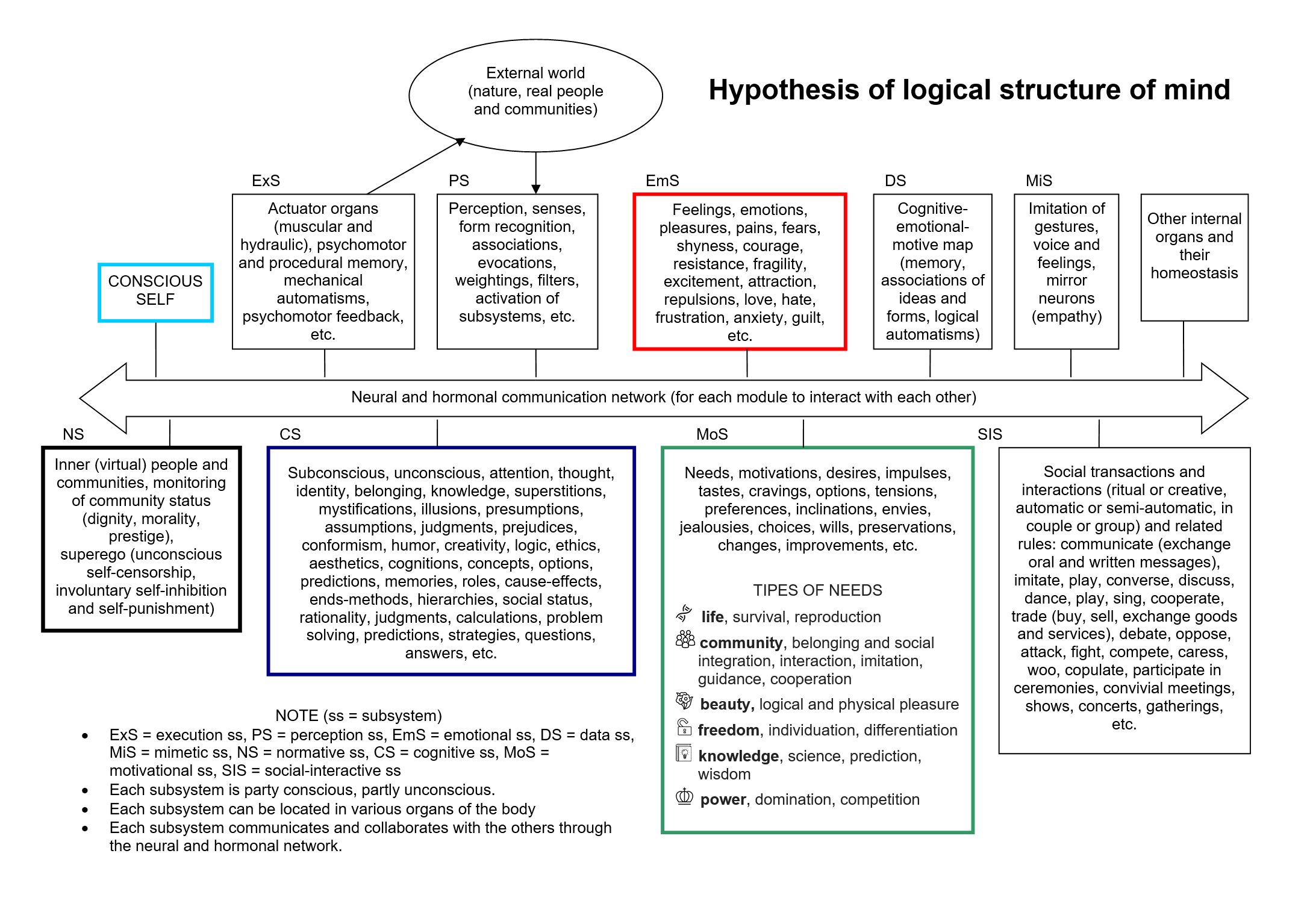Consistently with what has been said in the previous chapters, we can assume that the human mind is a system that is part of a higher level system, and that it is in turn made up of parts, or lower level systems. To know and understand the mind it is therefore necessary to analyze:
- the system to which it belongs
- with which other parts of that system (and how) it interacts
- from which parts it is constituted
- how these parts interact with each other.
This is a “systemic” approach to the knowledge of mind, applicable to any other entity.
Since we cannot (yet) observe the structure of the mind in a direct way, we only have to make assumptions about it from the study of human behavior, introspection and the results of neurobiological research. This procedure is similar to the so-called “reverse engineering” of computer engineers who, having lost the source code of a certain software, try to reconstruct it by deducing it from the external behavior of the host computer and from the examination of the binary code active in its memory.
That said, we can reasonably assume that the system of level immediately superior to which a mind belongs is what we call with various names including “person”, “individual”, “organism”, “body” etc.
The term “individual” etymologically means “not divisible”. However, today we know that it is actually “divided” into parts, although these cannot be removed without causing death or serious malfunctions of the individual himself. As Antonio Damasio teaches us, the Cartesian division of the person into body and mind is therefore wrong. In fact the mind is part of the body that hosts it, besides the fact that it cannot be circumscribed nor localized in any precise point of it. It is also necessary to remember that an information (which is an immaterial entity) cannot exist without something material that supports or transports it, so a mind (which is an information processor) cannot exist without a body that holds it.
As we have already said in a previous chapter, in order to understand something it is necessary to first divide it into parts (logical or physical) and then mentally reunite them by observing the relationships that bind them.
Having shown that it would not make sense to divide the “person” into body and mind, that is in a physical and a mental part (in fact even cells have a mind) the first significant division of a “person” (i.e. a human body) is in my opinion the one between the conscious self and the rest of the body, which we can therefore call “unconscious body”.
By “conscious self” or “consciousness” I mean the mysterious entity that makes us feel aware of ourselves, of existing, of feeling, of making choices and expressing wills.
Having defined the conscious self, the unconscious body is defined by subtraction:
unconscious body = total body – conscious self
The conscious self has the ability (real or illusory, as we will see in the chapter dedicated to free will) to command the voluntary muscles of the body that hosts it, although the same voluntary muscles can also be controlled by automatisms of which the subject is unaware.
We can therefore say that the unconscious body consists of a large amount (in the order of billions and more) of cybernetic subsystems of various levels completely automatic and not subject to the will of the conscious self, with few exceptions.
We can also suppose that the subsystems that compose the unconscious body interact according to certain logics (genetically determined or learned interactively) that keep the organism alive and ensure the reproduction of its species.
We can suppose that the interaction between the subsystems of the unconscious body occurs through the nervous system (which we can consider as the internet of the body), the hormonal system, and perhaps in other ways that science has not yet identified.
The following figure represents in a simplified way (but not too reductive) the parts in which the mind can be subdivided and the complex interactions between the automatisms of the unconscious body that we can hypothesize. These are grouped in a series of hypothetical subsystems, which communicate and interact with each other through the neural and hormonal network.
The “neural and hormonal network” is represented by a two-pointed arrow, a symbol used in computer science to represent a “bus”, i. e. an electronic device that allows all the components connected to it to exchange data with each other, thus avoiding direct physical connections between the components. In fact, thanks to the “bus”, each component uses only one connector instead of one for each component with which it interacts.
I have indicated with a colored border the subsystems that I consider most important from a psychological point of view.
The conscious self is the only subsystem endowed with awareness and (perhaps) free will. All the others are unconscious. However, the conscious self exchanges information with other subsystems so that, for example, it is able to feel feelings (input from the emotional subsystem), impulses (input from the motive subsystem), inhibitions and constraints (input from the normative subsystem), to think notions (input from the cognitive subsystem), to recognize situations and objects present (input from the perceptual subsystem) and to issue commands to the voluntary muscles (output to the execution subsystem).
The functions of the various subsystems, mentioned in the relevant boxes, as well as their interconnections, will be analyzed in the following chapters.
Next chapter: Subjectivity and awareness (consciousness).

